Performance Analysis of Topologies for Autonomous Hybrid Microgrids in Remote Non-Interconnected Communities in the Amazon Region
Abstract
:1. Introduction
2. PV-Diesel-Battery Microgrid Topologies
2.1. DC-Coupling Topology
2.2. AC-Coupling Topology
3. Comparative Analyses
3.1. Dispersed Versus Centralized AC-Coupling Topologies
3.1.1. Analytical Approach
3.1.2. Simulation Approach
3.2. AC- Versus DC-Coupling Topologies
3.2.1. Analytical Approach
3.2.2. Simulation Approach
4. Conclusions
Author Contributions
Funding
Conflicts of Interest
References
- Grimoni, J.A.B.; Galvão, L.C.R.; Udaeta, M.E.M.; Kanayma, P.H. Introduction to Concepts of Energy Systems for Clean Development [Iniciação a conceitos de sistemas energéticos para o desenvolvimento limpo], 2nd ed.; Edusp: São Paulo, Brazil, 2015. [Google Scholar]
- The World Bank. The World Bank Data. 2018. Available online: https://data.worldbank.org/country/brazil?view=chart (accessed on 10 May 2018).
- International Energy Agency. WEO-2017 Special Report: Energy Access Outlook; International Energy Agency: Paris, France, 2017. [Google Scholar]
- Macedo, W.N.; Monteiro, L.G.; Gorgozinho, I.M.; Macedo, E.N.; Rendeiro, G.; Braga, V.; Bacha, L. Biomass based microturbine system for electricity generation for isolated communities in amazon region. Renew. Energy 2016, 91, 323–333. [Google Scholar] [CrossRef]
- REN21. Renewables 2019: Global Status Report; REN21 Secretariat: Paris, France, 2019. [Google Scholar]
- González-Eguino, M. Energy poverty: An overview. Renew. Sustain. Energy Rev. 2015, 47, 377–385. [Google Scholar] [CrossRef]
- Figueirêdo Neto, G.S.; Rossi, L.A. Photovoltaic energy in the enhancement of indigenous education in the Brazilian Amazon. Energy Policy 2019, 132, 216–222. [Google Scholar] [CrossRef]
- Andrade, C.S.; Rosa, L.P.; da Silva, N.F. Generation of electric energy in isolated rural communities in the Amazon Region a proposal for the autonomy and sustainability of the local populations. Renew. Sustain. Energy Rev. 2011, 15, 493–503. [Google Scholar] [CrossRef]
- Cuesta, M.A.; Castillo-Calzadilla, T.; Borges, C.E. A critical analysis on hybrid renewable energy modeling tools: An emerging opportunity to include social indicators to optimise systems in small communities. Renew. Sustain. Energy Rev. 2020, 122, 109691. [Google Scholar] [CrossRef]
- Udaeta, M.E.M.; Gimenes, A.L.V.; Rigolin, P.H.D.; Bernal, J.L.D. Model of Energy Planning Considering both Energy Supply & Demand as Resources for Sustainable Development. In Energy Planning: Approaches and Assessment, 1st ed.; Gonzalez, J., Ed.; Nova Science Publisher: Hauppauge, NY, USA, 2016; pp. 1–34. [Google Scholar]
- Udaeta, M.E.M.; Galvão, L.C.R.; da Rigolin, P.H.C.; de, O.; Bernal, J.L. Full assessment energy-sources for inclusive energy-resources planning. Renew. Sustain. Energy Rev. 2016, 66, 190–206. [Google Scholar] [CrossRef]
- de, O.; Bernal, J.L. Model of Integration of Energy Resources with Consideration of Delimiters of Potential Energy Resources Aiming at the Preferential Plan of Integrated Resource Planning [Modelo de Integração de Recursos Energéticos com Consideração de Delimitadores de Pote; Escola Politécnica da Universidade de São Paulo: São Paulo, Brazil, 2018. [Google Scholar]
- da, C.; Rigolin, P.H. Development of a System to Classify Energy Resources of Supply and Demand based on the Calculation and Valuation of the Full Potential of Energy Resources within the Integrated Planning of Energy Resources [Desenvolvimento de um Sistema para Classificar r; Escola Politécnica da Universidade de São Paulo: São Paulo, Brazil, 2013. [Google Scholar]
- Maruyama, F.M.; Udaeta, M.E.M.; da Silva, V.O.; Gimenes, A.L.V. Bases for the Preferential Plan from an Integrated Energy Resources Planning; IOP Conf. Ser. Earth Environ. Sci. 2018, 188, 012046. [Google Scholar] [CrossRef]
- Cross, S.; Padfield, D.; Ant-Wuorinen, R.; King, P.; Syri, S. Benchmarking island power systems: Results, challenges, and solutions for long term sustainability. Renew. Sustain. Energy Rev. 2017, 80, 1269–1291. [Google Scholar] [CrossRef]
- Sánchez, A.S.; Torres, E.A.; Kalid, R.A. Renewable energy generation for the rural electrification of isolated communities in the Amazon Region. Renew. Sustain. Energy Rev. 2015, 49, 278–290. [Google Scholar] [CrossRef]
- Hatziargyriou, N.; Margaris, I.; Stavropoulou, I.; Papathanassiou, S.; Dimeas, A. Noninterconnected Island Systems: The Greek Case. IEEE Electrif. Mag. 2017, 5, 17–27. [Google Scholar] [CrossRef]
- Yao, L.; Shi, X.; Andrews-Speed, P. Conceptualization of energy security in resource-poor economies: The role of the nature of economy. Energy Policy 2018, 114, 394–402. [Google Scholar] [CrossRef]
- Ehnberg, J. Generation Reliability for Isolated Power Systems with Solar, Wind and Hydro Generation; Chalmers University of Technology: Gothenburg, Sweden, 2003. [Google Scholar]
- Mazzone, A. Decentralised energy systems and sustainable livelihoods, what are the links? Evidence from two isolated villages of the Brazilian Amazon. Energy Build. 2019, 186, 138–146. [Google Scholar] [CrossRef]
- Ahadi, A.; Kang, S.K.; Lee, J.H. A novel approach for optimal combinations of wind, PV, and energy storage system in diesel-free isolated communities. Appl. Energy 2016, 170, 101–115. [Google Scholar] [CrossRef]
- Shahsavari, A.; Akbari, M. Potential of solar energy in developing countries for reducing energy-related emissions. Renew. Sustain. Energy Rev. 2018, 90, 275–291. [Google Scholar] [CrossRef]
- Carta, J.A.; González, J.; Gómez, C. Operating results of a wind-diesel system which supplies the full energy needs of an isolated village community in the Canary Islands. Sol. Energy 2003, 74, 53–63. [Google Scholar] [CrossRef]
- Chauhan, A.; Saini, R.P. Techno-economic feasibility study on Integrated Renewable Energy System for an isolated community of India. Renew. Sustain. Energy Rev. 2016, 59, 388–405. [Google Scholar] [CrossRef]
- Ranaboldo, M.; Domenech, B.; Reyes, G.A.; Ferrer-Martí, L.; Pastor Moreno, R.; García-Villoria, A. Off-grid community electrification projects based on wind and solar energies: A case study in Nicaragua. Sol. Energy 2015, 117, 268–281. [Google Scholar] [CrossRef] [Green Version]
- Hills, J. Getting the Measure of Fuel Poverty: Final Report of the Fuel Poverty Review; ASE: London, UK, 2012. [Google Scholar]
- Al-Shamma’a, A.A.; Addoweesh, K.E. Techno-economic optimization of hybrid power system using genetic algorithm. Int. J. Energy Res. 2014, 38, 1608–1623. [Google Scholar] [CrossRef]
- Rashed, M.; Elmitwally, A.; Kaddah, S. New control approach for a PV-diesel autonomous power system. Electr. Power Syst. Res. 2008, 6, 949–956. [Google Scholar] [CrossRef]
- Malla, S.G.; Bhende, C.N. Enhanced operation of stand-alone ‘Photovoltaic-Diesel Generator-Battery’ system. Electr. Power Syst. Res. 2014, 107, 250–257. [Google Scholar] [CrossRef]
- Ohijeagbon, O.D.; Oluseyi, A.; Waheed, O.; Adekojo, M.; Salawu, E.Y.; Oyawale, F.A. Design of Optimal Hybrid Renewable Energy System for Sustainable Power Supply to Isolated-grid Communities in North Central, Nigeria. Procedia Manuf. 2019, 35, 278–284. [Google Scholar] [CrossRef]
- Rakhshani, E.; Mehrjerdi, H.; Iqbal, A. Hybrid wind-diesel-battery system planning considering multiple different wind turbine technologies installation. J. Clean. Prod. 2020, 247, 119654. [Google Scholar] [CrossRef]
- Martinez, J.R.; Saidel, M.A.; Fadigas, E.A. Influence of non-dispatchable energy sources on the dynamic performance of MicroGrids. Electr. Power Syst. Res. 2016, 131, 96–104. [Google Scholar] [CrossRef]
- Ayodele, T.R.; Ogunjuyigbe, A.S.O.; Ibitoye, T.Y. Optimal selection of pumped hydro storage based renewable energy generator(s) for isolated community using binary sort and search algorithm. Renew. Energy Focus 2019, 28, 100–111. [Google Scholar] [CrossRef]
- Sharafi, M.; ElMekkawy, T.Y. A dynamic MOPSO algorithm for multiobjective optimal design of hybrid renewable energy systems. Int. J. Energy Res. 2014, 38, 1949–1963. [Google Scholar] [CrossRef]
- Hassan, M.A.; Abido, M.A. Real time implementation and optimal design of autonomous microgrids. Electr. Power Syst. Res. 2014, 109, 118–127. [Google Scholar] [CrossRef]
- Xiao, J.; Bai, L.; Li, F.; Liang, H.; Wang, C. Sizing of energy storage and diesel generators in an isolated Microgrid using discrete fourier transform (DFT). IEEE Trans. Sustain. Energy 2014, 5, 907–916. [Google Scholar] [CrossRef]
- Mizani, S.; Yazdani, A. Design and operation of a remote microgrid. In Proceedings of the 2009 35th Annual Conference of IEEE Industrial Electronics, Porto, Portugal, 3–5 November 2009; pp. 4299–4304. [Google Scholar] [CrossRef]
- Liu, G.; Starke, M.; Xiao, B.; Zhang, X.; Tomsovic, K. Microgrid optimal scheduling with chance-constrained islanding capability. Electr. Power Syst. Res. 2017, 145, 197–206. [Google Scholar] [CrossRef] [Green Version]
- Bhuiyan, F.A.; Yazdani, A.; Primak, S.L. Optimal sizing approach for islanded microgrids. IET Renew. Power Gener. 2015, 9, 166–175. [Google Scholar] [CrossRef]
- Alharbi, H.; Bhattacharya, K. Optimal sizing of battery energy storage systems for Microgrids. In Proceedings of the 2014 IEEE Electrical Power and Energy Conference, Calgary, AB, Canada, 12–14 November 2014. [Google Scholar]
- HOMER Energy LLC. HOMER ENERGY” The HOMER Pro® Microgrid Software by HOMER Energy. Available online: https://www.homerenergy.com/ (accessed on 26 September 2020).
- Balderrama, S.; Lombardi, F.; Riva, F.; Canedo, W.; Colombo, E.; Quoilin, S. A two-stage linear programming optimization framework for isolated hybrid microgrids in a rural context: The case study of the ‘El Espino’ community. Energy 2019, 188, 116073. [Google Scholar] [CrossRef]
- de Christo, T.M.; Perron, S.; Fardin, J.F.; Simonetti, D.S.L.; de Alvarez, C.E. Demand-side energy management by cooperative combination of plans: A multi-objective method applicable to isolated communities. Appl. Energy 2019, 240, 453–472. [Google Scholar] [CrossRef]
- Mandelli, S.; Merlo, M.; Colombo, E. Novel procedure to formulate load profiles for off-grid rural areas. Energy Sustain. Dev. 2016, 31, 130–142. [Google Scholar] [CrossRef]
- Mi, Y.; Chen, X.; Ji, H.; Ji, L.; Fu, Y.; Wang, C.; Wang, J. The coordinated control strategy for isolated DC microgrid based on adaptive storage adjustment without communication. Appl. Energy 2019, 252, 113465. [Google Scholar] [CrossRef]
- Nguyen, M.Y.; Yoon, Y.T. A comparison of Microgrid topologies considering both market operations and reliability. Electr. Power Components Syst. 2014, 6, 585–594. [Google Scholar] [CrossRef]
- Phrakonkham, S.; Le Chenadec, J.Y.; Diallo, D.; Remy, G.; Marchand, C. Reviews on MicroGrid configuration and dedicated hybrid system optimization software tools: Application to Laos. Eng. J. 2010, 14, 20. [Google Scholar] [CrossRef] [Green Version]
- Mariam, L.; Basu, M.; Conlon, M.F. A Review of Existing Microgrid Architectures. J. Eng. 2013, 2013, 1–8. [Google Scholar] [CrossRef] [Green Version]
- Justo, J.J.; Mwasilu, F.; Lee, J.; Jung, J. AC-microgrids versus DC-microgrids with distributed energy sources: A review. Renew. Sustain. Energy Rev. 2013, 24, 387–405. [Google Scholar] [CrossRef]
- Castillo-Calzadilla, T.; Macarulla, A.M.; Kamara-Esteban, O.; Borges, C.E. A case study comparison between photovoltaic and fossil generation based on direct current hybrid microgrids to power a service building. J. Clean. Prod. 2020, 244, 118870. [Google Scholar] [CrossRef]
- International Electrotechnical Commission. Photovoltaic System Performance Monitoring—Guidelines for Measurement, Data Exchange and Analysis—IEC 61724; International Electrotechnical Commission: Geneva, Switzerland, 1998; Available online: https://webstore.iec.ch/preview/info_iec61724%7Bed1.0%7Den.pdf. (accessed on 26 September 2020).
- Operador Nacional do Sistema. Operation Results: Operation History [Resultados da Operação: Histórico da Operação]; Hourly Load Curve; 2018. Available online: http://www.ons.org.br/paginas/resultados-da-operacao/historico-da-operacao (accessed on 26 September 2020).
- Empresa de Pesquisa Energética. Brazilian Energy Balance 2018: Year 2017 [Balanço Energético Nacional 2018: Ano base 2017]; Empresa de Pesquisa Energética: Rio de Janeiro, Brazil, 2018. Available online: http://epe.gov.br/sites-pt/publicacoes-dados-abertos/publicacoes/PublicacoesArquivos/publicacao-303/topico-419/BEN2018.pdf. (accessed on 26 September 2020).
- Kundur, P. Power System Stability and Control; McGraw-Hill: New York, NY, USA, 1994. [Google Scholar]
- Gonzalez, S.; Stein, J.; Fresquez, A.; Ropp, M.; Schutz, D. Performance of utility interconnected photovoltaic inverters operating beyond typical modes of operation. In Proceedings of the 2013 IEEE 39th Photovoltaic Specialists Conference, Tampa Bay, FL, USA, 16–21 June 2013; pp. 2879–2884. [Google Scholar] [CrossRef]
- Saidel, M.A.; Fadigas, E.; Martinez, A.; Mocelin, J.; Haideier, R.; Mendonça, B.; Valer, L.; Flores, T.; Zucchi, M.; Barros, C.; et al. Mini-Networks with Intermittent Sources to Serve Isolated Areas [Minirredes com Fontes Intermitentes para Atendimento de áreas Isoladas]; Escola Politécnica da Universidade de São Paulo: São Paulo, Brazil, 2016. [Google Scholar]
- Al Essa, M.J.M. Power management of grid-integrated energy storage batteries with intermittent renewables. J. Energy Storage 2020, 31, 101762. [Google Scholar] [CrossRef]
- Benlahbib, B.; Bouarroudj, N.; Mekhilef, S.; Abdeldjajil, D.; Abdelkrim, T.; Bouchafaa, F.; Iakhdari, A. Experimental investigation of power management and control of a PV/wind/fuel cell/battery hybrid energy system microgrid. Int. J. Hydrogen Energy 2020. [Google Scholar] [CrossRef]
- Martinez-Bolanos, J.R.; Udaeta, M.E.M.; Gimenes, A.L.V.; da Silva, V.O. Economic feasibility of battery energy storage systems for replacing peak power plants for commercial consumers under energy time of use tariffs. J. Energy Storage 2020, 29, 101373. [Google Scholar] [CrossRef]
- SMA. SMA Energy System Home; Solar Inverters. Available online: https://www.sma.de/en/products/solarinverters.html. (accessed on 26 September 2020).
- SMA, “SUNNY ISLAND 4.4M / 6.0H / 8.0H,” Proven Technology Now Even More Affordable. Available online: https://www.sma.de/en/products/battery-inverters/sunny-island-44m-60h-80h.html (accessed on 26 September 2020).
- Fulguris, “Battery [Bateria],” Products [Produtos]. Available online: http://www.fulguris.com.br/ (accessed on 20 June 2003).
- Morningstar, “Produt Catalog,” Products. Available online: https://www.morningstarcorp.com/ (accessed on 26 September 2020).
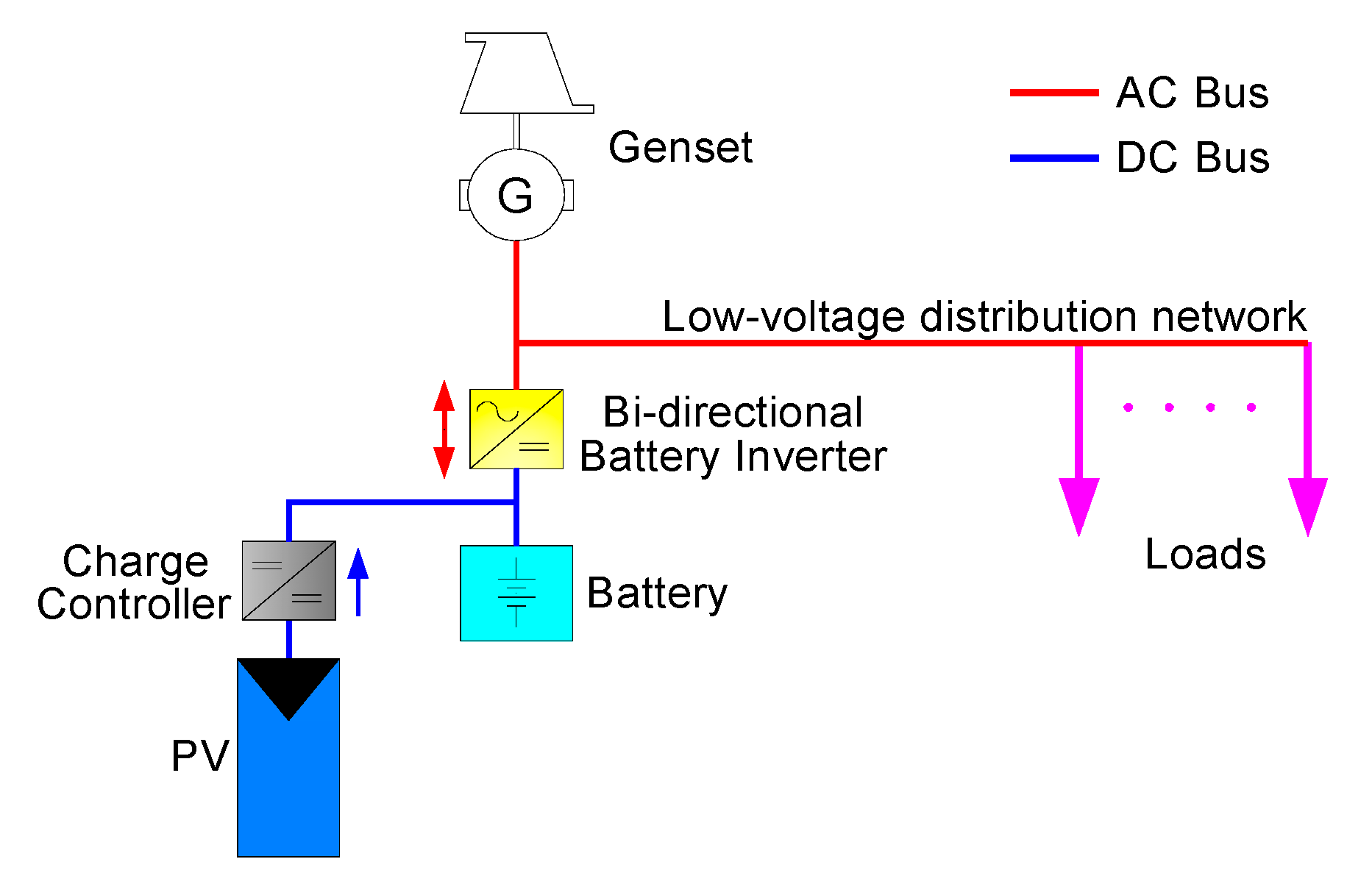


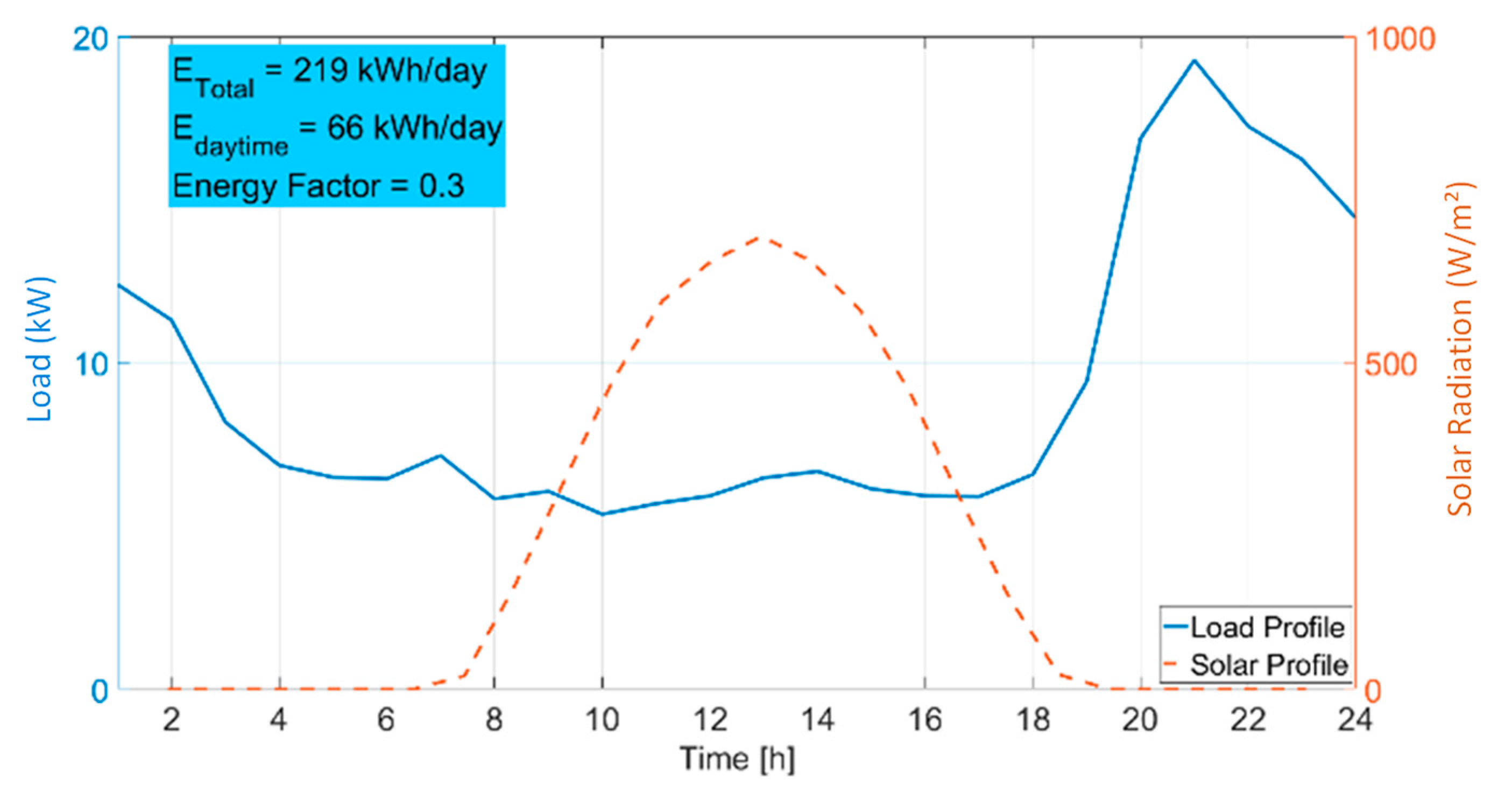

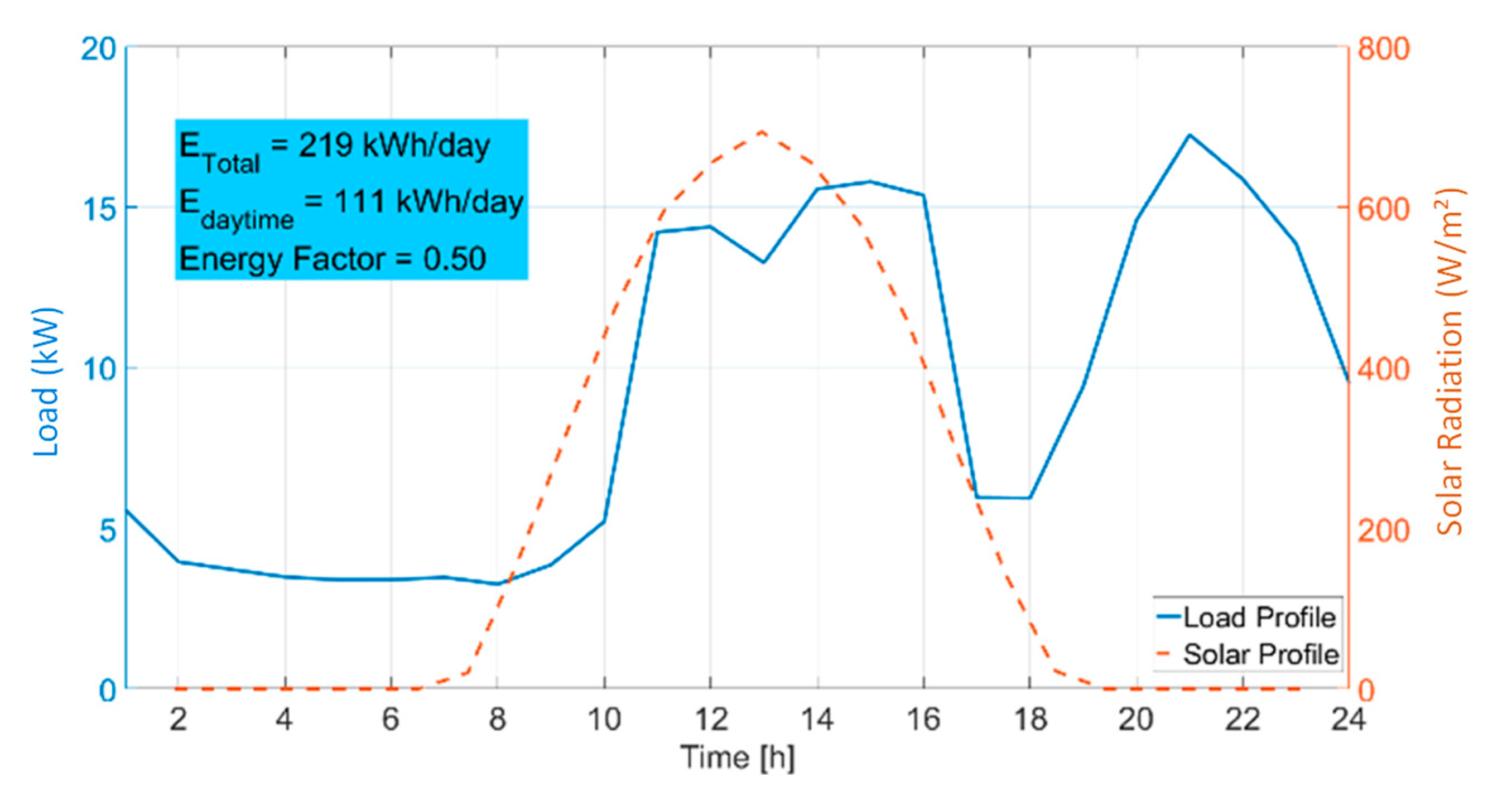

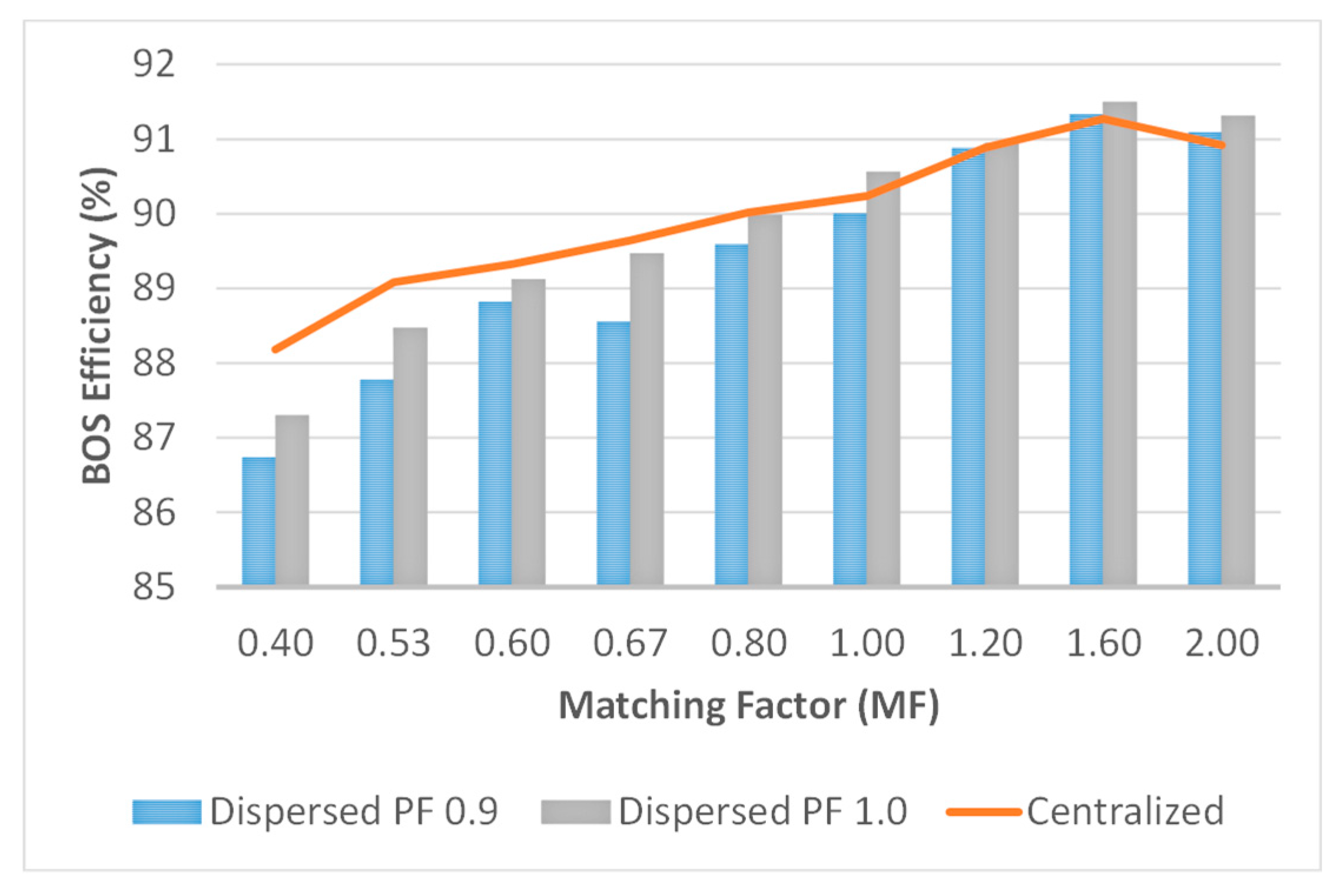
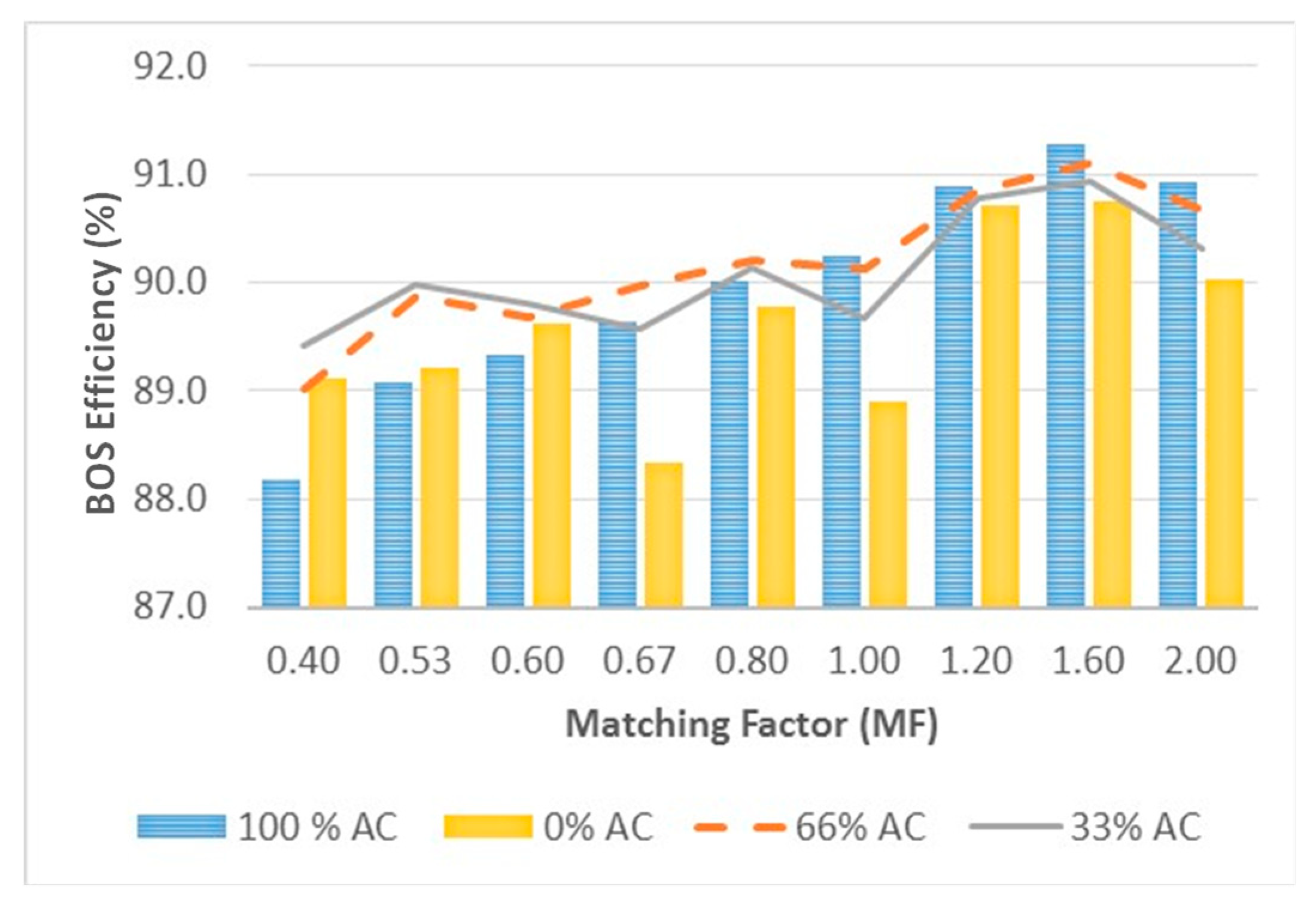
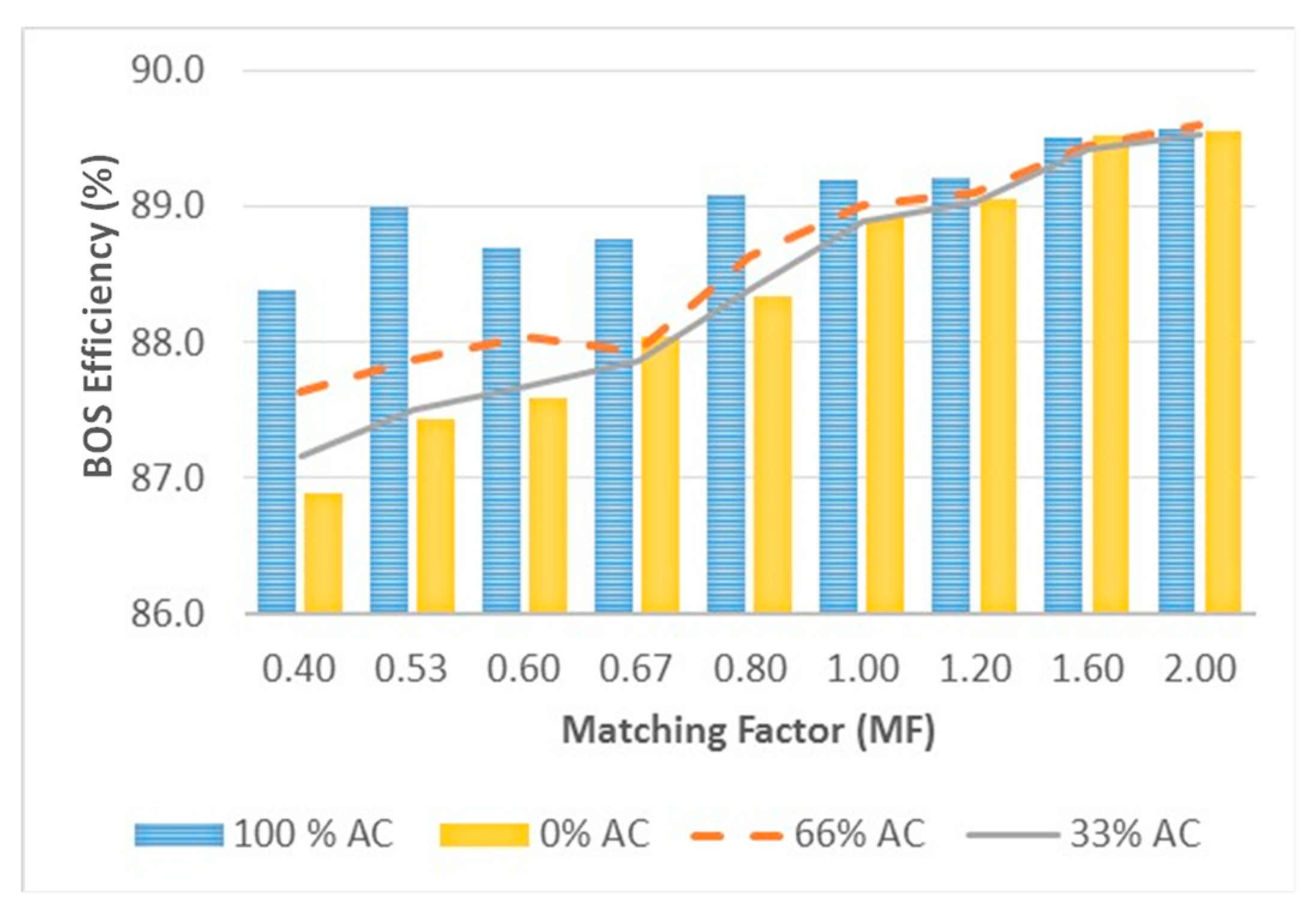
| EF | PVPenetration (%) | MF | Power Losses (kWh/y) | ||
|---|---|---|---|---|---|
| PF = 1.0 | PF = 0.9 | ||||
| Dispersed | Centralized | Dispersed | |||
| 0.3 | 25 | 1.20 | 1028 | 1137 | 1145 |
| 0.3 | 50 | 0.60 | 1386 | 1146 | 1717 |
| 0.3 | 75 | 0.40 | 2157 | 1159 | 2812 |
| 0.4 | 25 | 1.60 | 816 | 1045 | 978 |
| 0.4 | 50 | 0.80 | 1064 | 1051 | 1482 |
| 0.4 | 75 | 0.53 | 1735 | 1064 | 2523 |
| 0.5 | 25 | 2.00 | 941 | 1356 | 1165 |
| 0.5 | 50 | 1.00 | 1033 | 1362 | 1573 |
| 0.5 | 75 | 0.67 | 1556 | 1374 | 2529 |
| Component | Efficiency |
|---|---|
| PV inverter (with MPPT) | 0.96 |
| Battery inverter | 0.93 |
| Charge controller (with MPPT) | 0.95 |
| Battery efficiency | 0.87 |
| Matching Factor | Esolar (%) | ||
|---|---|---|---|
| AC-Coupled | DC-Coupled | ||
| Low | 72% Esolar | 77% Esolar | 3.8% |
| High | 96% Esolar | 88% Esolar | 2.0% |
Publisher’s Note: MDPI stays neutral with regard to jurisdictional claims in published maps and institutional affiliations. |
© 2020 by the authors. Licensee MDPI, Basel, Switzerland. This article is an open access article distributed under the terms and conditions of the Creative Commons Attribution (CC BY) license (http://creativecommons.org/licenses/by/4.0/).
Share and Cite
Martinez-Bolaños, J.; Silva, V.; Zucchi, M.; Heideier, R.; Relva, S.; Saidel, M.; Fadigas, E. Performance Analysis of Topologies for Autonomous Hybrid Microgrids in Remote Non-Interconnected Communities in the Amazon Region. Sustainability 2021, 13, 44. https://doi.org/10.3390/su13010044
Martinez-Bolaños J, Silva V, Zucchi M, Heideier R, Relva S, Saidel M, Fadigas E. Performance Analysis of Topologies for Autonomous Hybrid Microgrids in Remote Non-Interconnected Communities in the Amazon Region. Sustainability. 2021; 13(1):44. https://doi.org/10.3390/su13010044
Chicago/Turabian StyleMartinez-Bolaños, Julio, Vinícius Silva, Mariana Zucchi, Raphael Heideier, Stefania Relva, Marco Saidel, and Eliane Fadigas. 2021. "Performance Analysis of Topologies for Autonomous Hybrid Microgrids in Remote Non-Interconnected Communities in the Amazon Region" Sustainability 13, no. 1: 44. https://doi.org/10.3390/su13010044





